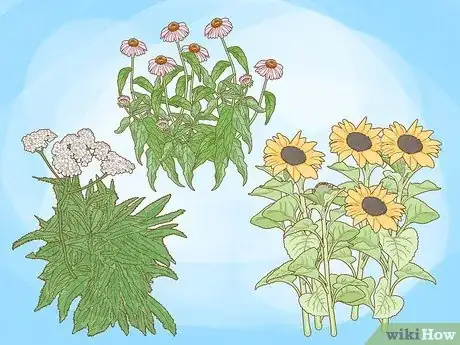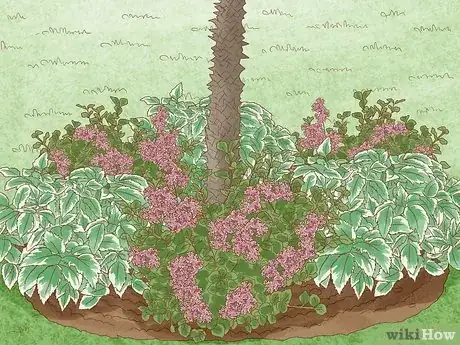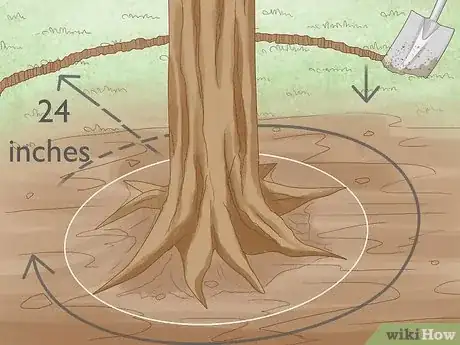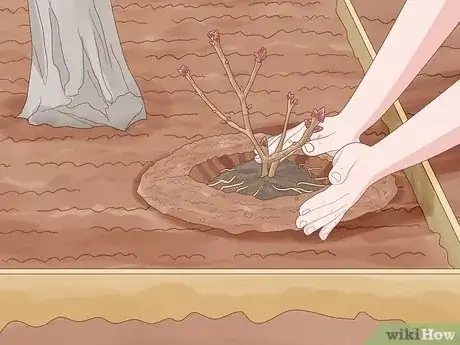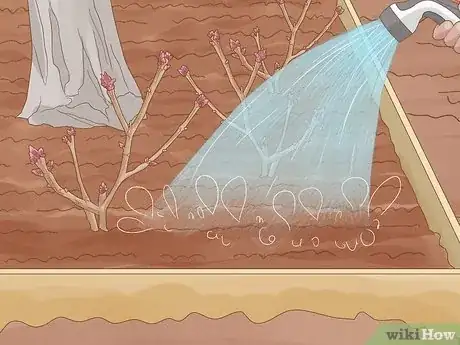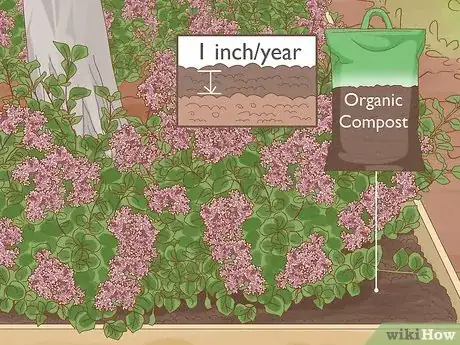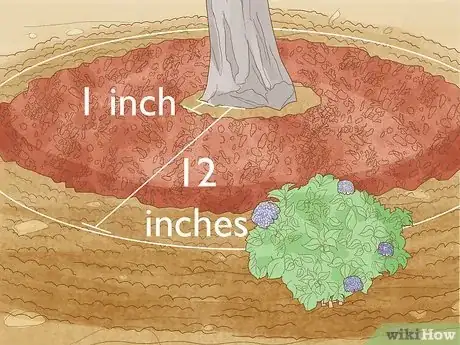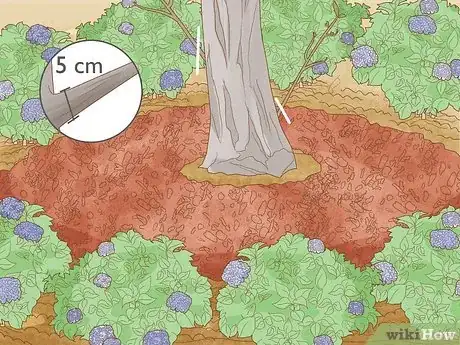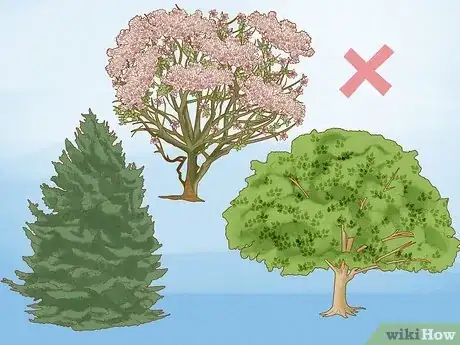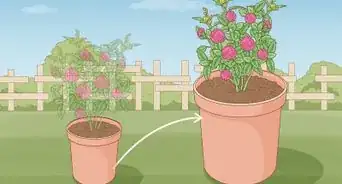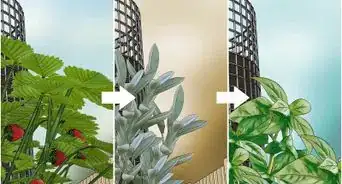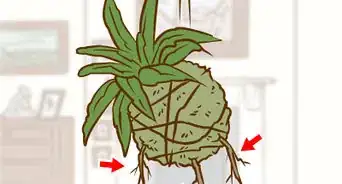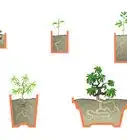This article was co-authored by Andrew Carberry, MPH. Andrew Carberry is a Food Systems Expert and the Senior Program Associate at the Wallace Centere at Winrock International in Little Rock, Arkansas. He has worked in food systems since 2008 and has experience working on farm-to-school projects, food safety programs, and working with local and state coalitions in Arkansas. He is a graduate of the College of William and Mary and holds a Masters degree in public health and nutrition from the University of Tennessee.
There are 10 references cited in this article, which can be found at the bottom of the page.
wikiHow marks an article as reader-approved once it receives enough positive feedback. This article received 13 testimonials and 100% of readers who voted found it helpful, earning it our reader-approved status.
This article has been viewed 471,824 times.
When you are planting a garden around your tree, protect your tree by following some simple guidelines about outlining the area for your bed, applying topsoil, and avoiding the tree roots when planting. Then select plants that are compatible with your geographical region and the specific shade requirements of your garden plot. Lastly, learn how to plant your bed and maintain the plants with regular watering and care.
Steps
Choosing the Plants
-
1Grow plants that are sun or shade compatible with your planting area. You first need to know how much sun exposure your bed receives. Observe your garden over the course of a day, and consider how your shade and sunlight levels will change in the different seasons. When buying plants, the descriptions will indicate how much sun they will need.
- Full sun means that during the middle of the day in the growing season the area will get six or more hours of direct sunlight. If this is the case for your bed, you will have a wide range of plants you can choose from.
- Partial sun means that the area receives direct sunlight from the sunrise until noon. The reason this is not full sun is because the sun in the morning is not as strong as sun in the middle of the day.
- Partial shade is when your spot receives sunlight from 3 p.m. until the end of the day. Partial shade also applies to areas that have dappled or filtered sunshine for the full day.
- Full shade would mean that the area is on the north side of a building or that the tree coverage is very dense and that even dappled sunshine does not show through. Although your options will be fewer, you can still find suitable, attractive plants for your bed.
-
2Pay attention to the mature size of the plant. Make sure that when the plant is full size that it will fit well under the tree and in the space you have. Buy small and low growing plants for your bed. Plants that will get tall may start to block sunlight for any smaller plants in the bed or encroach on the lower branches of tree.Advertisement
-
3Choose the flowers to plant under your tree. Planting flowers under your tree can make for a very attractive bed. Consider planting in a cluster of 3-5 different kinds of flowers or shrubs to create a more textured or flourishing look. Consider the zone where you are planting as well. When you buy plants, make sure they are suited for your region. For example, if you live in the desert, there are many flowers that are difficult to successfully grow in the summer because of the heat.
-
4Choose a shrub to plant under your tree. These plants are easy to maintain and can add great variety to your bed. You will want to make sure that whatever shrub you buy is low growing. Once again, consider the sunlight and region where you live when you are selecting your plants. Shrubs are great for growing under trees because they can thrive with less light and/or moisture.
Planting and After-Care
-
1Know when to plant. You should plant any flower other than a pansy after the last frost of the spring. Pansies are heartier and can withstand the cold. Other flowers will die if you plant them and a frost comes. Find the average last frost date from the previous year. Search online at plantmap.com for the last frost in your area. You can also use the National Centers for Environmental Information (NCEI) to obtain data on the last frost date in your location. [1] [2]
- Certain plants will thrive best if they are planted during a specific time or at certain temperatures, so pay attention to the care instructions for your plant. For example, irises grow best if you plant them in the late summer or early fall instead of in the spring. [3] You can go to www.garden.org to read more about how to care for your specific plant. [4]
- Note when you are buying your plants that annuals will grow just one season and perennials will last at least two seasons.
-
2Set a perimeter for your bed. You don’t need to create a border; however, you should know where the perimeter of your bed is to know where to plant. Take a shovel and mark off the diameter of the bed. Remember that you should start planting a foot out from the trunk of the tree, so 24 inches may be a good place to make a perimeter.
-
3Build a raised bed around your tree. Do not dig up the soil around your tree because you may end up digging up the roots with the soil. Instead, create a bed of soil around your tree. You can just dump soil around the tree to create the bed, or you can use bricks or logs as a border for the outer edges of the soil.
- Make sure to make the soil bed around the tree deep enough for your plants to fit into.
-
4Take the plant carefully out of its container. If it is a small pack with several flowers, push up from the bottom and lift the plant out from the roots. Untangle any roots that are stuck to the bottom of the container. If it is a potted plant, place your hand over the surface of the soil, and turn the plant over into the palm of your hand.
-
5Loosen the roots of the plant. Take the outside of the root ball, and gently untangle some of the roots at the edge of the root ball. You do not want the roots to remain a dense mass, and untangling them a bit will allow the roots to plant more easily into the new soil.
-
6Place the plant in the hole, and cover it with soil. Gently put the plant into the new soil, and take your new topsoil and cover the flower roots. Then press down on the soil around the base of the flower with your hands. Now your plant is almost set- repeat the above steps to plant the rest of your shrubs and flowers before you water.
- Hold the plant by the roots rather than by the stems at all times.
-
7Leave your plants room to grow, and weed your flower bed regularly. When you are planting, do not plant the flowers or shrubs too close together. Find out how big the plants are going to grow, and consider how densely you want the area to be populated with plants. Leave at least 2-3 inches of space between each plant. In addition, you should maintain your flower bed by weeding regularly. Use your hands and pluck out any unwanted plants that are growing around your flowers and plants by the root. If weeds are left unattended they can choke your flowers and take their nutrients.
- Make a schedule on your calendar for when you should be weeding your flower bed to help keep you on track with your weeding.
-
8Water the area where you have planted your flowers thoroughly. Water consistently after you have planted your plants. When the plants roots have to compete with the roots of a tree they will need more water. Set a watering schedule for your plants to help you keep track of when you have watered them and when you will need to water them again.
-
9Every year add another inch of organic matter to your garden. You can add organic matter or more topsoil to your garden that is suited for your kinds of flowers, perennial or annual. You need to add organic matter because the bacteria and fungi in organic matter is food for your plants. You can make your own organic matter for your garden by composting. Using your vegetable scraps, garden clippings, leaves or manure, you can provide the nutrients your plants need to thrive year after year.
Protecting Your Tree
-
1Leave about an inch between the base of the tree and any mulch.[5] Place the mulch about 1 inch from the base of the tree and start planting about 12 inches from the tree’s trunk. Plant outwards from there. Make sure that where the trunk becomes wider and the roots are exposed that the bark remains uncovered. Do not create a raised flower bed around the tree base. The bark on the exposed roots of a tree needs oxygen, and if the roots are covered they will rot over time.[6]
-
2Trim the low branches of your tree. [7] You want to allow as much light as you can to reach the flowers and plants below your tree. So get out a pair of trimming shears and trim any low, thin branches. Remember, however, that living branches should be on at least ⅔ of the plant’s height, so never trim more than ⅓ of the living branches of your tree. [8]
- You can get pruning shears at a hardware store.[9]
- Only remove branches that are less than 5 cm in diameter.
- Trim thin V-shaped branches. Avoid trimming healthy U-shaped branches.
- If you are pruning a small branch, trim it about 1/4 inch out from a bud. If you are pruning a larger branch, then cut it just outside the raised collar area outside of the trunk.[10]
-
3Know what kind of tree you are planting under. Depending on the kind of tree you are planting under, you should be more careful about how many plants you plant. You may want to plant under a tree that is better suited for gardening at its base. If you do have a tree that is more sensitive, consider starting small and choose a few small plants rather than creating a dense garden at the base of the tree. If you have a tree that is sensitive, create a plan for your garden that will span a few years, so your tree can gradually acclimate to the new planting. [11]
- Be cautious when planting under these trees because they are sensitive about having their roots disturbed:
- Beeches
- Black oak
- Buckeyes
- Cherries and plums
- Dogwoods
- Hemlocks
- Larches
- Lindens
- Magnolias
- Pines
- Red oaks
- Scarlet oaks
- Sugar maples
- Be cautious when planting under these trees because they are sensitive about having their roots disturbed:
Expert Q&A
Did you know you can get expert answers for this article?
Unlock expert answers by supporting wikiHow
-
QuestionCan I grow vegetables, like spinach, in a tree flower bed?
 Andrew Carberry, MPHAndrew Carberry is a Food Systems Expert and the Senior Program Associate at the Wallace Centere at Winrock International in Little Rock, Arkansas. He has worked in food systems since 2008 and has experience working on farm-to-school projects, food safety programs, and working with local and state coalitions in Arkansas. He is a graduate of the College of William and Mary and holds a Masters degree in public health and nutrition from the University of Tennessee.
Andrew Carberry, MPHAndrew Carberry is a Food Systems Expert and the Senior Program Associate at the Wallace Centere at Winrock International in Little Rock, Arkansas. He has worked in food systems since 2008 and has experience working on farm-to-school projects, food safety programs, and working with local and state coalitions in Arkansas. He is a graduate of the College of William and Mary and holds a Masters degree in public health and nutrition from the University of Tennessee.
Food Systems Expert
-
QuestionHow do I plant flower beds under pine trees?
 Community AnswerLook for plants, trees and shrubs that love acidic soil. My mom had irises, columbines, hyacinth, forsythia, rosemary, dogwood, and violets as a cover crop (evergreen in zone 7); I forget what else. A search for acid-loving plants will get you a long list.
Community AnswerLook for plants, trees and shrubs that love acidic soil. My mom had irises, columbines, hyacinth, forsythia, rosemary, dogwood, and violets as a cover crop (evergreen in zone 7); I forget what else. A search for acid-loving plants will get you a long list. -
QuestionShould I place mulch on top of the soil after the plants are in?
 Community AnswerYou can place a shallow layer of the tree's leaves to help hold moisture to your plants, but avoid covering the roots of the tree or getting closer than 12 inches to the base. This natural leaf mulch is the best option. You can turn your leaves into finer mulch by running over them with a mulching lawnmower, using the bag to capture them. The grass mixed in with the leaves will not hurt and will make a great organic mulch as well! Avoid pine straw, as this is acidic and your tree and plants may find it too strong if they are not acid-lovers.
Community AnswerYou can place a shallow layer of the tree's leaves to help hold moisture to your plants, but avoid covering the roots of the tree or getting closer than 12 inches to the base. This natural leaf mulch is the best option. You can turn your leaves into finer mulch by running over them with a mulching lawnmower, using the bag to capture them. The grass mixed in with the leaves will not hurt and will make a great organic mulch as well! Avoid pine straw, as this is acidic and your tree and plants may find it too strong if they are not acid-lovers.
References
- ↑ http://www.plantmaps.com/interactive-california-last-frost-date-map.php
- ↑ http://www.ncdc.noaa.gov/cdo-web/results
- ↑ http://www.garden.org/plantguide/?q=show&id=2036
- ↑ http://www.garden.org/plantguide/
- ↑ http://homeguides.sfgate.com/placing-raised-flower-bed-around-oak-tree-44557.html
- ↑ http://www.gardeningknowhow.com/ornamental/trees/tgen/planting-garden-beneath-trees.htm
- ↑ http://www.gardeningknowhow.com/ornamental/trees/tgen/planting-garden-beneath-trees.htm
- ↑ http://www.treehelp.com/how-to-prune-a-tree/
- ↑ http://www.treeremoval.com/trimming-and-pruning/#.VeOlpSVViko
About This Article
If you want to create tree flower beds, choose plants that are sun and shade compatible with your tree. Watch your tree for a couple days to see what time of day it gets sunlight. Then, choose 3-5 different kinds of low-lying flowers and shrubs that will do well in your climate and with that amount of sunlight. After you have selected your plants, build a raised bed around your tree and plant the flowers and shrubs at least a foot away from the tree trunk. If you want, you can create a perimeter around your plants using rocks. For tips from our Gardener reviewer on how to build a raised bed, keep reading!


